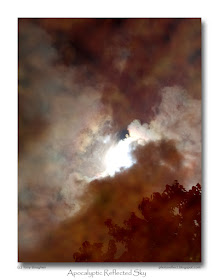 click photo to enlarge
click photo to enlargeHere's my recipe for a photograph of an apocalyptic sky in the style of the English Romantic painter, John Martin (1789-1854).
Ingredients
One grimy bird bath
A stormy sky, ideally featuring both sun and thunder
One tree
Method
Prepare your bird bath by leaving it exposed to the elements for a few years. Fill it with tap water when it dries out, otherwise let the rain do its job. When the bird bath grows a patina of orange lichen try and scrape it off. Please note, you won't succeed in this task, but that doesn't matter since the remaining patches distort the everyday colours reflected in the water in a preternatural way.
On a day when thunder is rumbling around, the broken clouds are of various shades of white and grey, and the sun is making intermittent appearances, crouch down with your camera fitted with a macro lens and try and get a focus lock on the clouds reflected in the bird bath. If the autofocus keeps finding the surface of the water, or the orange patches of lichen just below the surface, either switch to manual focus or wait for the sharp edge of a cloud to appear against the brightness of the sun: the latter usually produces an autofocus lock, and also stirs the colours up nicely, adding pinks, oranges, purples, etc. In order to anchor the image in the real world, as opposed to creating a shot that is entirely from the dream world of a deranged imagination, make sure your position allows you to include part of the reflected tree. Then press the shutter.
Serving
You can either take the shot as it comes, or post-process to taste. I like to increase the contrast very slightly to enhance the image's "end of the world" feel.
There will be some people who'll tell you that a photograph secured in this way looks contrived, unreal, "out of this world.", and must be the product of post-processing tricks. Take such remarks as compliments rather than the slurs that are intended, then show them the original RAW file. The close correspondence between the two will help them to understand that our world holds an infinity of weird and wonderful images that can be captured directly, without any need to resort to Photoshoppery.
photograph & text (c) T. Boughen
Camera: Olympus E510
Mode: Aperture Priority
Focal Length: 35mm macro, (70mm/35mm equiv.)
F No: f6.3
Shutter Speed: 1/400
ISO: 100
Exposure Compensation: 0 EV
Image Stabilisation: On